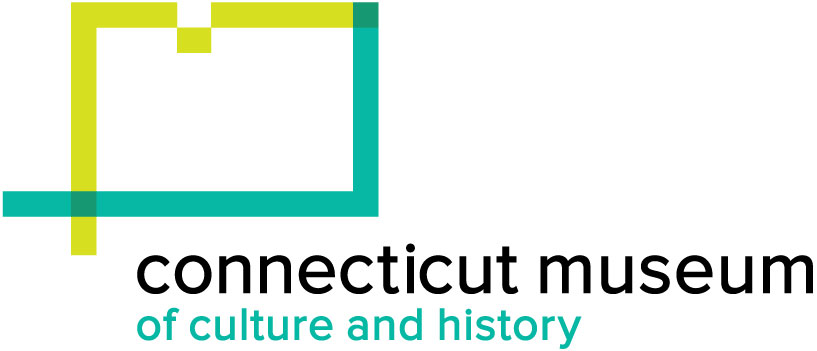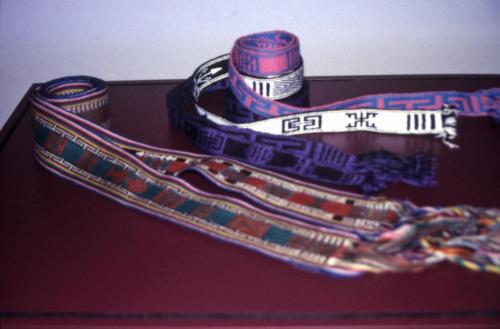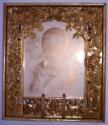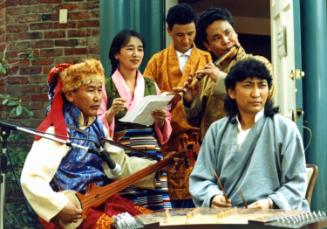Exhibit Installation of Auspicious Signs: Tibetan Arts in New England
Date1996
MediumPhotography
ClassificationsGraphics
Credit LineConnecticut Cultural Heritage Arts Program collections
CopyrightIn Copyright
Object number2015.196.227.1-.20
DescriptionImages of the installation of the "Auspicious Signs: Tibetan Arts in New England" exhibit at the Institute for Community Reseach Gallery in Hartford, 1996.
2015.196.227.1: Slide showing chorten made by Sonam Lama on the right, carpet woven by Phurbu Kyipa on the wall
2015.196.227.2: Slide showing blanket and woman's apron woven by Tsering Yangzom
2015.196.227.3: Slide showing chorten made by Sonam Lama, and prayer flags
2015.196.227.4: Slide showing carved frame made by Ngawang Choedar, with picture of His Holiness the Dalai Lama, beloved spiritual and political leader of Tibet. Pine, carved with bamboo saw and chisels.
2015.196.227.5: Slide showing two walls of installation
2015.196.227.6: Slide showing chorten, prayer flags, and paintings by Kalsang Jorden (left) and Jampa Tsondue (right)
2015.196.227.7: Slide showing chorten, prayer flags, and paintings by Kalsang Jorden (left) and Jampa Tsondue (right)
2015.196.227.8: Slide showing prayer flags and chorten built by Sonam Lama
2015.196.227.9: Slide showing Sonam Lama building the chorten.
2015.196.227.10: Slide showing front and back view of end panels from a table, carved by Ngawang Choedar, made of pine, carved with bamboo saw and chisels from one piece of wood.
2015.196.227.11: Slide showing exhibit title lettering at gallery entrance
2015.196.227.12: Slide showing paintings by Kalsang Jorden
2015.196.227.13: Slide showing painting of the Eight Auspicious Symbols of Buddhism by Kalsang Jorden. Drawn, painted, or carved throughout Tibet, these decorative motifs symbolize important principles and historical events within Buddhism:
Lotus Flower: symbol of purity, rising from earthly roots to enlightenment
Vase: sacred vessel holding hidden treasures
Dharma Wheel (Chakra): representing the unity of all things, symbol of Buddha
Golden Fish: signifying spiritual liberation through Buddhism
Endless Knot: the unity of all things and the illusory nature of time
The Banner of Victory: symbolizing victory over ignorance and death
Canopy: a token of loyalty and protection, deriving from the practice of kings placing their umbrellas over open-air shrines
Conch Shell: used in ritual as a trumpet or offering vessel; symbol of the spoken word. Acrylics on canvas. CHS collection
2015.196.227.14: Slide showing paintings by Kalsang Jorden (two on left) and Jampa Tsondue (two on right).
Far left: Painting of a peacock, which in Tibetan Buddhist tradition represents the important spiritual process of turning negative emotions into positive personal development. The peacock is said to eat poisons to make its feathers more beautiful. Poster colors on canvas. Collection of the Connecticut Historical Society
Near left: Thangka painting of Chenrezig (Avalokitesvara), god of compassion. One of the guiding principles of Tibetan Buddhism, compassion is embodied by the Dalai Lama. Acrylic and poster colors on canvas.
Near right: Illustration for a Tibetan story, a princess offers her crown to three monks seeking alms, in a gesture of generosity and renunciation of worldly goods. Monks often travel widely, depending upon others to offer food and lodging in the spirit of goodwill. They carry a bell which is rung three times at each house. Natural pigments on paper
Far right: Tibetan thangka, religious painting of Namkhai Nyingbo, Boddhisattva of compassion, holding a lotus in leaf, bloom, and bud, representing the life and wisdom of Buddha, past, present, and future. (deity). Natural pigments and gold on prepared cotton
2015.196.227.15: Slide showing four paintings by Kalsang Jorden
2015.196.227.16: Slide showing entrance to the exhibit with title and prayer flags
2015.196.227.17: Slide showing tablet-woven belts made by Tsering Yangzom
2015.196.227.18: Slide showing close view of chorten made by Sonam Lama. Constructed as metaphors for the body and evolution of Buddha, the square chorten base stands for earth, the cylinder is water, the thirteen rings on the shaft represent the stages toward enlightenment. The top is crowned by a brass piece carrying symbols of the sacred flame of Buddha (fire); the half moon (air) and sun (infinite space) unite compassion and wisdom at the moment of Buddha's attainment of Nirvana. Inside the chorten Sonam has placed coins, turquoise, gold, silver, herbs, and sandalwood in honor of the deity of the north, one of the kings of the four directions. Underneath are a toy gun and tools, representing the burying of anger and attachment to earthly goods. Twenty-nine books of mantras are placed inside as written prayers to Buddha and other spiritual figures, bringing heart and spirit to the chorten's body. This chorten is dedicated to Namgyal, the goddess of long
2015.196.227.19: Slide showing two paintings by Jampa Tsondue
Left: Illustration for a Tibetan story, a princess offers her crown to three monks seeking alms, in a gesture of generosity and renunciation of worldly goods. Monks often travel widely, depending upon others to offer food and lodging in the spirit of goodwill. They carry a bell which is rung three times at each house. Natural pigments on paper.
Right: Tibetan thangka, religious painting of Namkhai Nyingbo, Boddhisattva of compassion, holding a lotus in leaf, bloom, and bud, representing the life and wisdom of Buddha, past, present, and future. (deity) Natural pigments and gold on prepared cotton.
2015.196.227.20: Slide showing carpet woven by hand on a large frame loom by Phurbu Kyipa. Traditionally, carpets are used to cover seats and beds, as wall hangings, and in monasteries as cushions, back rests, drum covers, or pillar covers.
NotesSubject Note: "Auspicious Signs: Tibetan Arts in New England" was an exhibit project developed by the Connecticut Cultural Heritage Arts Program (CCHAP) at the Institute for Community Research in Hartford in 1996. The exhibit opening and a festival of Tibetan arts and music served as the major public events of an eighteen-month research and programming project conducted by CCHAP in partnership with the Tibetans. The project celebrated the Tibetan community's preservation and practice of their traditions in America.2015.196.227.1: Slide showing chorten made by Sonam Lama on the right, carpet woven by Phurbu Kyipa on the wall
2015.196.227.2: Slide showing blanket and woman's apron woven by Tsering Yangzom
2015.196.227.3: Slide showing chorten made by Sonam Lama, and prayer flags
2015.196.227.4: Slide showing carved frame made by Ngawang Choedar, with picture of His Holiness the Dalai Lama, beloved spiritual and political leader of Tibet. Pine, carved with bamboo saw and chisels.
2015.196.227.5: Slide showing two walls of installation
2015.196.227.6: Slide showing chorten, prayer flags, and paintings by Kalsang Jorden (left) and Jampa Tsondue (right)
2015.196.227.7: Slide showing chorten, prayer flags, and paintings by Kalsang Jorden (left) and Jampa Tsondue (right)
2015.196.227.8: Slide showing prayer flags and chorten built by Sonam Lama
2015.196.227.9: Slide showing Sonam Lama building the chorten.
2015.196.227.10: Slide showing front and back view of end panels from a table, carved by Ngawang Choedar, made of pine, carved with bamboo saw and chisels from one piece of wood.
2015.196.227.11: Slide showing exhibit title lettering at gallery entrance
2015.196.227.12: Slide showing paintings by Kalsang Jorden
2015.196.227.13: Slide showing painting of the Eight Auspicious Symbols of Buddhism by Kalsang Jorden. Drawn, painted, or carved throughout Tibet, these decorative motifs symbolize important principles and historical events within Buddhism:
Lotus Flower: symbol of purity, rising from earthly roots to enlightenment
Vase: sacred vessel holding hidden treasures
Dharma Wheel (Chakra): representing the unity of all things, symbol of Buddha
Golden Fish: signifying spiritual liberation through Buddhism
Endless Knot: the unity of all things and the illusory nature of time
The Banner of Victory: symbolizing victory over ignorance and death
Canopy: a token of loyalty and protection, deriving from the practice of kings placing their umbrellas over open-air shrines
Conch Shell: used in ritual as a trumpet or offering vessel; symbol of the spoken word. Acrylics on canvas. CHS collection
2015.196.227.14: Slide showing paintings by Kalsang Jorden (two on left) and Jampa Tsondue (two on right).
Far left: Painting of a peacock, which in Tibetan Buddhist tradition represents the important spiritual process of turning negative emotions into positive personal development. The peacock is said to eat poisons to make its feathers more beautiful. Poster colors on canvas. Collection of the Connecticut Historical Society
Near left: Thangka painting of Chenrezig (Avalokitesvara), god of compassion. One of the guiding principles of Tibetan Buddhism, compassion is embodied by the Dalai Lama. Acrylic and poster colors on canvas.
Near right: Illustration for a Tibetan story, a princess offers her crown to three monks seeking alms, in a gesture of generosity and renunciation of worldly goods. Monks often travel widely, depending upon others to offer food and lodging in the spirit of goodwill. They carry a bell which is rung three times at each house. Natural pigments on paper
Far right: Tibetan thangka, religious painting of Namkhai Nyingbo, Boddhisattva of compassion, holding a lotus in leaf, bloom, and bud, representing the life and wisdom of Buddha, past, present, and future. (deity). Natural pigments and gold on prepared cotton
2015.196.227.15: Slide showing four paintings by Kalsang Jorden
2015.196.227.16: Slide showing entrance to the exhibit with title and prayer flags
2015.196.227.17: Slide showing tablet-woven belts made by Tsering Yangzom
2015.196.227.18: Slide showing close view of chorten made by Sonam Lama. Constructed as metaphors for the body and evolution of Buddha, the square chorten base stands for earth, the cylinder is water, the thirteen rings on the shaft represent the stages toward enlightenment. The top is crowned by a brass piece carrying symbols of the sacred flame of Buddha (fire); the half moon (air) and sun (infinite space) unite compassion and wisdom at the moment of Buddha's attainment of Nirvana. Inside the chorten Sonam has placed coins, turquoise, gold, silver, herbs, and sandalwood in honor of the deity of the north, one of the kings of the four directions. Underneath are a toy gun and tools, representing the burying of anger and attachment to earthly goods. Twenty-nine books of mantras are placed inside as written prayers to Buddha and other spiritual figures, bringing heart and spirit to the chorten's body. This chorten is dedicated to Namgyal, the goddess of long
2015.196.227.19: Slide showing two paintings by Jampa Tsondue
Left: Illustration for a Tibetan story, a princess offers her crown to three monks seeking alms, in a gesture of generosity and renunciation of worldly goods. Monks often travel widely, depending upon others to offer food and lodging in the spirit of goodwill. They carry a bell which is rung three times at each house. Natural pigments on paper.
Right: Tibetan thangka, religious painting of Namkhai Nyingbo, Boddhisattva of compassion, holding a lotus in leaf, bloom, and bud, representing the life and wisdom of Buddha, past, present, and future. (deity) Natural pigments and gold on prepared cotton.
2015.196.227.20: Slide showing carpet woven by hand on a large frame loom by Phurbu Kyipa. Traditionally, carpets are used to cover seats and beds, as wall hangings, and in monasteries as cushions, back rests, drum covers, or pillar covers.
Since the Tibetan Resettlement Project brought twenty-one Tibetans to live in Connecticut, the state has become home to one of the fastest growing Tibetan communities in the United States. Several Connecticut Tibetans are traditional artists of great skill who are deeply committed to expressing and passing on Tibetan culture. Members of the Tibetan community are also dedicated to educating others about the difficult history and circumstances of the Chinese occupation of Tibet.
The collaborative project team consisted of three Tibetan project assistants, exhibit designer Sarah Buie, the Tibetan Cultural Center of Connecticut, artist Sonam Lama who was at the time Vice President of the Massachusetts Tibetan Association, and curator/folklorist Lynne Williamson, then director of CCHAP. The interdisciplinary nature of the team served to broaden the project's outreach to regional Tibetan communities as well as to incorporate a rich variety of expertise and perspectives.
The project team produced an exhibit displaying Tibetan religious art as well as everyday traditional arts, a day-long festival featuring artists, performers, demonstrations, and discussions, and an illustrated catalogue. Artists Jampa Tsondue, Ngawang Choedar, and Tsering Yangzom were featured in a video documenting their artistic process.
Funders included the Lila Wallace Readers Digest Community Folklife Program administered by the Fund for Folk Culture and underwritten by the Lila Wallace-Reader's Digest Fund; the National Endowment for the Arts Folk and Traditional Arts Program, the Connecticut Commission on the Arts, the Connecticut Humanities Council and the Institute for Community Research.
To mark the exhibit opening, the Tibetan community held a festival attended by over three hundred people, including Tibetans from all over the region. Four music and dance groups performed outside, while in the exhibit gallery three Tibetan artists demonstrated weaving, woodcarving, and thangka painting. The event also featured a bazaar, a common Tibetan cultural activity. Many Tibetans are keen traders, maintaining links to Dharamsala, India, and Nepal through import of goods to the U.S. and sale through small shops here. Six Tibetan vendors from all over the region set up tables during the festival with a great variety of Tibetan books and crafts. Lakedhen and five other community members had risen at dawn to prepare food, which they sold during the day. Several speakers described the background of the project, the story of the Connecticut community, the current political situation in Tibet, and the history and character of Tibetan culture. Cholsum dance group from New York City and musicians Lakedhen and Thupten performed and accompanied the dancers. Singer DaDon and her group played for over an hour.
Cataloging Note: This project was made possible in part by the Institute of Museum and Library Services MA-245929-OMS-20.
Status
Not on viewJampa Tsondue
2018 March 10

































